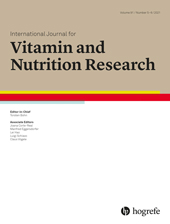Tribulus Terrestris may decrease muscle damage markers following a high-intensity resistance exercise: A pilot study
Abstract
Abstract. The purpose of this study was to investigate the effect of two weeks of Tribulus Terrestris (TT) on the responses of Interleukin-6 (IL-6), high sensitivity C-reactive protein (hs-CRP), and enzymes creatine phosphokinase (CPK) and lactate dehydrogenase (LDH) following a single session of resistance exercise (RE). Eighteen healthy non-athlete males (age: 22.44 ± 2.54 years, BMI: 26.15 ± 1.62 kg/m2) participated in this study and were divided randomly into two 9-person groups of supplementation or placebo. The participants consumed two 250-mg capsules of TT or placebo (maltodextrin) per day and performed six REs with the intensity 80, 85, and 90% of 1RM in three circles at the day after the end of supplementation period. Blood samples were collected before the initiation of supplementation, and before and after the RE session. Total changes of IL-6 (p<0.001) and LDH (p=0.005) were significant in both groups. Bonferroni post hoc test showed that increased values of IL-6 and CPK in both groups were significant after exercise compared with pre-exercise and baseline (p<0.001). There were no significant differences in relation to within- and between-group changes in hs-CRP (p>0.05). Moreover, differences between the groups regarding post-exercise IL-6 and CPK were not significant (p>0.05). However, post-exercise LDH in supplementation group were lower than placebo group (p=0.015). In conclusion, short-term supplementation with TT has no effect on IL-6 and hs-CRP, but may be effective on the reduction of muscle damage enzymes CPK and LDH following high-intensity circuit RE.
References
1 . A review of the effects of leucine metabolite (β-Hydroxy-β-methylbutyrate) supplementation and resistance training on inflammatory markers: a new approach to oxidative stress and cardiovascular risk factors. Antioxidants. 2018;7:148–159.
2 Cytokine and hormone responses to resistance training. Eur. J. Appl. Physiol. 2009;107:397–409.
3 . Exercise and cytokines with particular focus on muscle derived IL-6. Exerc. Immunol. Rev. 2001;7:18–31.
4 . Effects of resistance training on the inflammatory response. Nutr. Res. Pract. 2010;4:259–269.
5 Carbohydrate and the cytokine response to 2.5 h of running. Eur. J. Appl. Physiol. 1997;82:1662–1667.
6 . The anti-inflammatory effect of exercise: its role in diabetes and cardiovascular disease control. Essays Biochem. 2006;42:105–117.
7 . Lack of relationship between interleukin-6 and CRP levels in healthy male athletes. Immunol. Lett. 2005;99:136–140.
8 Exercise Training and Plasma C-Reactive Protein and Interleukin-6 in Elderly People. J. Am. Geriatr. Soc. 2008;56:2045–2052.
9 Changes in blood lipid peroxidation markers and antioxidants after a single sprint anaerobic exercise. Eur. J. Appl. Physiol. 2003;89:14–20.
10 . Effect of moderate and high resistance training intensity on indices of inflammatory and oxidative stress. Res. Sports. Med. 2015;23:73–87.
11 . Oxidative Stress. Sports. Med. 2006;36:327–358.
12 . Effects of resistance or aerobic exercise training on interleukin-6, C-reactive protein, and body composition. Med. Sci. Sports Exerc. 2010;42:304–313.
13 . Tribullus Terrestris’ supplementation improves the antioxidant system of resistance trained subjects. SL. Nutr. Metab. 2017;1:113–119.
14 . Effects of Tribulus tertesris extract on body weight, testis histopathology and size in rats. Vet. Clin. Path. (Vet. J. Tabriz). 2011;5:1043–1049. [In Persian]
15 . Insights into supplements with Tribulus terrestris used by athletes. J. Hum. Kinet. 2014;41:99–105.
16 . The effect of five weeks of Tribulus terrestris supplementation on muscle strength and body composition during preseason training in elite rugby league players. J. Strength. Cond. Res. 2007;21:348–353.
17 . The influence of the Tribulus terrestris extract on the parameters of the functional preparedness and athletes’ organism homeostasis. Fiziol. Zh. 2009;55:89–96.
18 . In vitro screening for anti-acetylcholiesterase, anti-oxidant, anti-glucosidase, anti-inflammatory and anti-bacterial effect of three traditional medicinal plants. Biotechnol. Biotechnol. Equip. 2014;28:1155–1164.
19 . The Effect of Oral Feeding of Tribulus Terrestris Fruit on Some Markers of Oxidative Stress in the Brain of Diabetic Rats. J. Shahid. Sadoughi. Univer. Med. Sci. 2013;21:127–135. [In Persian].
20 . Tribulus terrestris extracts alleviate muscle damage and promote anaerobic performance of trained male boxers and its mechanisms: Roles of androgen, IGF-1, and IGF binding protein-3. J. Sport. Health. Sci. 2015;20:1–8.
21 . Strength testing – predicting a one-rep max from reps-to-fatigue. J. Phys. Educ. Recreat. Dance. 1993;64:88–90.
22 . Designing Resistance Training Programs (4th ed.). Champaign: Human Kinetics; 2014.
23 . Influence of commonly employed resistance exercise protocols on circulating IL-6 and indices of insulin sensitivity. J. Strength. Cond. Res. 2010;24:1091–1101.
24 . Effects of mode and intensity on the acute exercise-induced IL-6 and CRP responses in a sedentary, overweight population. Eur. J. Appl. Physiol. 2011;111:1035–1045.
25 . Effect of resistance, endurance, and concurrent training on TNF-a, IL-6, and CRP. Med. Sci. Sports. Exerc. 2012;44:50–56.
26 Acute pro-and anti-inflammatory responses to resistance exercise in patients with coronary artery disease: a pilot study. J. Sport. Sci. Med. 2015;14:91–97.
27 . Response of Leptin and C-Reactive Protein to a Single Session Circuit Resistance Exercise in Over-weight Girl Student. Q. Horizon. Med. Sci. 2012;18:55–63. [In Persian].
28 . The Effect of 4 Weeks Resistance Training on Serum Vaspin, Il-6, CRP and TNF-a Concentrations in Diabetic Rats. Iran. J. Endocrinol. Metab. 2012;14:68–74. [In Persian].
29 . Changes in C-reactive protein, interleukin-6 and lipid biomarkers in sedentary middle-aged men after resistance exercise. J. Sabzevar. Univer. Med. Sci. 2014;21:283–292. [In Persian].
30 The effects of high intensity short rest resistance exercise on muscle damage markers in men and women. J. Strength. Cond. Res. 2014;28:1041–1049.
31 . Effects of different resistance exercise protocols on nitric oxide, lipid peroxidation and creatine kinase activity in sedentary males. J. Sport. Sci. Med. 2007;6:417–422.
32 Creatine kinase and lactate dehydrogenase responses after upper-body resistance exercise with different rest intervals. J. Strength. Cond. Res. 2010;24:1657–1662.
33 . Hormonal Responses, Indicators of Cell Damage and Concentration of Plasma Amino Acids following Acute Resistance Exercise with BCAA Supplement. J. Sport. Biosci. 2013;4:45–62. [In Persian].


